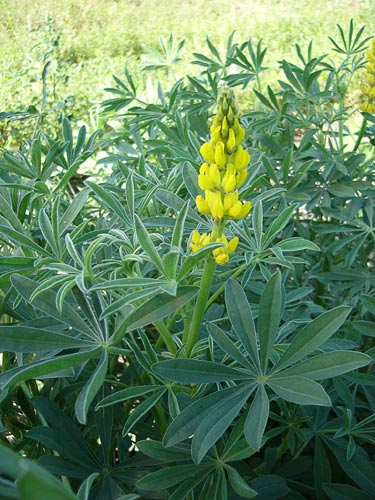Crops
Lupinus luteus L. - European yellow lupin
Taxonomic position.
Family Fabaceae Lindl., genus Lupinus L.Biology and morphology.
2n=46, 48, 52. Annual grassy plant with straight branching from base stem, 1-1.5 m in height. Strong, taprooted system with tubercles (nodule bacterium). Leaves are palmate, in groups of 9-11, lengthened, densely pubescent, pointed leaflets. Leafstalks are long. Stipules conjugate, pubescence at edges, symmetrical on the main stem, asymmetrical on lateral branches. Inflorescence: terminal spicate raceme with 6-10 whorls of fragrant flowers (with 5 flowers on short, pubescent pedicels within each whorl). Petals are yellow, orange, or whitish; 9 stamens; 5 upper ones are longer. Pods flat with dense pubescence, 4-5 cm in length, 1.1-1.3 cm wide, yellow-brown when ripening (deep brown in wet weather), with 3-5 seeds. Seeds are reniform, light cream, pinkish brown with black dots, rarely black in color. Weight of 100 seeds 120-140 g.Distribution.
Native land is western Mediterranean. Introduced in culture in 2000 B.C. as a foodstuff for people, also as forage and an officinal plant. Appeared in Russia about 1811 as ornamental plant, cultivated from the end of the 19th century. Occupies about 1.5 million hectares within the territory of the former USSR. Basic regions of cultivation include Belarussia, marshy woodlands of Ukraine, the Baltic States, and central regions of Russia.Ecology.
Quite a heat-loving plant. Optimal temperature for shoot development 10-14°C, for growth 20-25°C. Fares poorly in temperatures above 30°C. Shoots can bear frost at temperatures of 4-5°C. Photophilous. Requires moisture during root system development. Drought-resistant. Does not require high soil fertility. Can grow on sandy and sandy-loamy, slightly acidic to neutral soil. Vegetation period depends on method, year and place of cultivation, usually lasting between 90 and 175 days. Sometimes cross-pollinated.Economic value.
Feed crop. Used fresh as silage. Green mass, gathered during flowering, is 2.66% protein; hay 16.52% protein; silage 2.9% protein. Seeds are 50% protein, 5-20% oil and bitter alkaloids (up to 1.7%). New varieties are low-alkaloid (.sweet lupine.). Nitrogen-holder; accumulates 40-50 or more tons of nitrogen per hectare. Bitter lupine is cultivated for green fertilizer (siderat). Ornamental plant. Productivity of green mass 30-40 (60) tons per hectare; seeds 1.0-1.4 (2.7) tons per hectare. Varieties: BSHA 382, Bystrorastuzhij 4, Grodnenskij 3, Nosovskij belosemiannyj, Narochanskij, Akademicheskij, Kastrychnik, Kopylovskij, Zhitomirskij, Fakel, Zheltyi 45-46 (bitter).Literature cited.
Filatov N.K. 1972. Agrotechnics of yellow lupine. Leningrad: Lenizdat. 159 p.Kuptsov A.I. 1975. Introduction in geography of cultural plants. Moscow: Nauka. 296 p.
Kurlovitch B.S., Repiev S.I., eds. 1995. Genofund and selection of leguminous plants (lupine, vetch, soya, string-bean): Theoretical basis of selection. Vol 3. St. Petersburg: VIR. 432 p.
Kurlovich S., ed. 2002. Lupins (geography, classification, genetic resources and breeding). St.Petersburg.
Majsurian N.A., Atabekova A.I. 1974. Lupine. Moscow. 464 p.
Sinitsin E.M., ed. 1988. Yellow lupine for seeds. Moscow: Agropromizdat. 76 p.
Vehov V.N., Gubanov I.A., Lebedeva G.F. 1978. Cultural plants of the USSR. Moscow: Mysl'. 336 p.
Zhukovskij P.M. 1971. Cultural plants and their relatives. Leningad.
http://suhon.tele-kom.ru/lupin.htm
http://www.agro.ru/nauka/plant/spisok/lupkorm.htm


